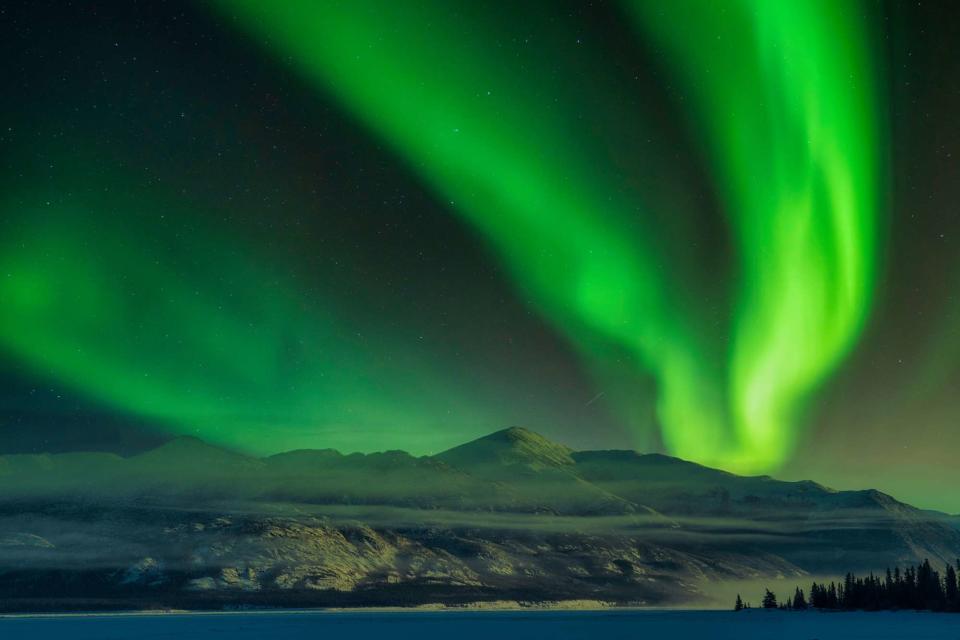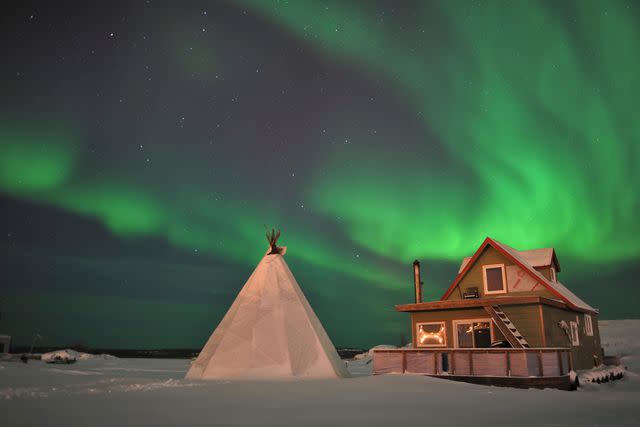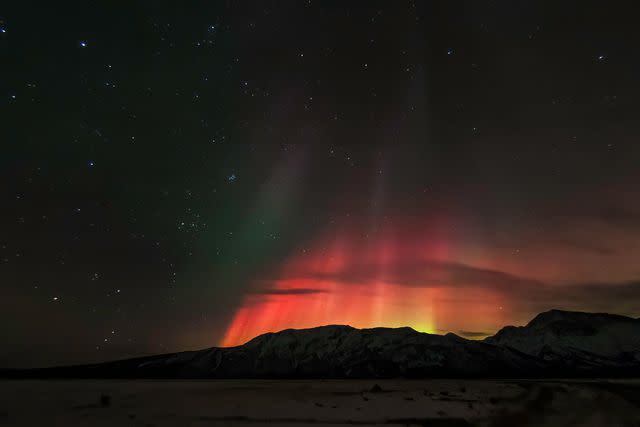What the Northern Lights Mean, According to Indigenous Communities in Canada
For centuries, humans have sought to explain the colorful northern lights and find meaning in them.

Luis F Arevalo/Getty Images
In a cozy lodge at the edge of Kluane National Park in the Yukon territory of Canada, my husband and I gathered with other guests around a wood-burning fireplace for an Indigenous storytelling experience. We snuggled around the fire while James Allen, an Elder and former Chief from the local Champagne and Aishihik First Nation, shared Southern Tutchone legends that he grew up with. My favorite legend was about the aurora borealis. “There are many legends about the northern lights,” Allen explained. “Our story is that the northern lights are a message from ancestors who have passed on. They dance in the Spirit World to let us know they are happy there.”
I was still thinking about the Southern Tutchone northern lights legend long after the storytelling session ended. I liked the idea that this mesmerizing natural phenomenon had a deeper meaning. As I thought about the people who had been close to me that have passed on, I hoped there was an afterlife and that they were happy there. I hoped they were dancing.
Debbie Olsen is an award-winning Métis writer and a national bestselling author. Follow her at www.wanderwoman.ca.
For thousands of years, mankind has tried to explain the swirling colorful ribbons of light that dance across the sky in northern climes. Scientists now know that the breathtaking northern lights are the result of electrically charged particles from the sun colliding with gasses in the Earth’s upper atmosphere. But centuries ago, people didn’t have the knowledge and tools needed to understand this phenomenon. In almost every ancient culture in this region of the world, legends were created to explain the unexplainable.

:Jiri Hermann/Stocktrek Images/Getty Images
To Whistle or Not to Whistle – That Is the Question
Susan Paskvan, a Koyukon Athabascan from the small village of Koyukuk, grew up in a landscape of tundra and mountains that has frequent auroral activity. “As children, we would whistle at the northern lights to make them move,” she said. “Even today when I whistle at the northern lights, I can see them move. In some cultures, they think it’s bad to whistle at an aurora, though.” Paskvan asked other people what their beliefs are about the aurora, and some said that when it dances, it is our ancestors dancing. When you whistle, it makes them dance, but traditionally, young children aren't supposed to whistle at night because the spirits might grab their spirit that isn't fully formed.
There are several different Indigenous groups whose legends advise children against whistling at the northern lights, and the Opaskwayak Cree Nation in northern Manitoba is one of them. “We were told as children that we shouldn’t whistle at the northern lights in the nighttime,” said Wilfred Buck in a YouTube video he created in 2016 when he worked as a science facilitator at the Manitoba First Nations Education Resource Centre. “If we did, they told us the northern lights would come to get us and take us away. Of course, we tried to whistle at the northern lights all the time.” Buck said he believed the legend was told to discourage children from running around in the bush after dark where they might be harmed by wild animals.
Many Nations, Many Legends
There are more than 50 different Indigenous Nations speaking 50 unique Indigenous languages in Canada. Each distinct nation has its own legends. Some northern lights legends are similar between Indigenous groups, while others are very different. Bobby Drygeese, a member of Yellowknives Dene First Nation, grew up hearing two vastly different northern lights legends – one from his mother’s side of the family and another from his father’s side. Drygeese shares these legends and other cultural experiences with guests of B. Dene Adventures, the tour company he owns and operates just outside of Yellowknife in Canada’s Northwest Territories.
“My parents came from two different areas and even though they were both Dene, there were different legends,” Drygeese explained. “My grandpa on my mother’s side used to tell me the northern lights were the spirits of our ancestors dancing in the sky. When the lights burn brightly, it’s because they are happy to see us and happy with how we’re living our lives.”

Gerald Corsi/Getty Images
Drygeese went on to explain a more complicated legend that came from his father’s side of the family. The legend tells of a young boy who used the northern lights to travel and ended up becoming a gifted healer. The boy used the northern lights to travel the vast lands to where people were sick and helped them. When it became cloudy, he was trapped on the other side of the Great Slave Lake. When the aurora borealis started shining again, he traveled home and explained where he had been. His parents realized he was a gifted healer. “When people see the northern lights, it’s a good thing,” Drygeese said. “It means you can expect the unexpected.”
The Northern Lights as a Navigation Tool
Indigenous Peoples have been using the northern lights as a tool for navigation for thousands of years. The brightly colored bands of light flow in an east-to-west direction along the auroral arc making them useful for wayfinding – a practical application for the aurora borealis.
Spirituality and Renewal
There are many different Indigenous groups living under the auroral oval, the area around Earth’s geomagnetic north pole where auroral activity is most frequently visible. Each group has its own myths and legends. “There are lots of myths and legends associated with the aurora,” admitted Dave Daley, a Métis man who owns and operates Wapusk Adventures, a tour company offering dogsledding and aurora viewing tours near Churchill, Manitoba. “I grew up with the Cree legend that the aurora is our departed ancestors dancing in the sky, but each legend and myth about the aurora is tied to renewal and spirituality.” Perhaps that is why viewing an aurora and hearing the legends associated with it is such a profoundly moving experience.
For more Travel & Leisure news, make sure to sign up for our newsletter!
Read the original article on Travel & Leisure.

